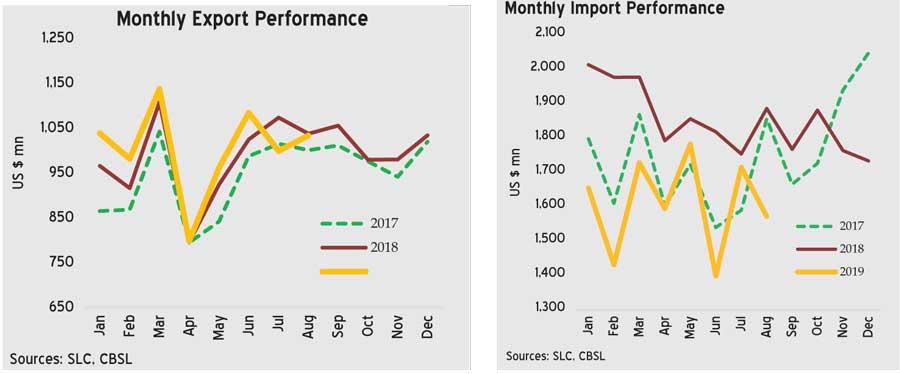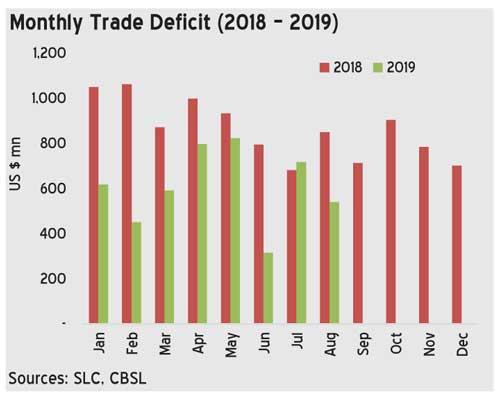15 Oct 2019 - {{hitsCtrl.values.hits}}

Sri Lanka’s imports, supported by lower vehicle and gold imports, continued to decline while exports largely recovered from its recent decline to see the island nation’s trade deficit narrowing in August, the trade data released by the Central Bank showed yesterday.
Imports fell by a sharp 16.6 percent year-on-year (YoY) in August to US $ 1.57 billion while earnings from exports declined marginally by 0.4 percent YoY to little over a billion dollars, mainly due to the lower prices of major export categories.
The trade deficit fell to US $ 540 million in August, from US $ 717 million in July and US $ 850 million a year ago.
Meanwhile, the cumulative trade deficit for the first eight months contracted to US $ 4.85 billion, from US $ 7.24 billion during the same period in 2018.

As of late, Sri Lanka has narrowed the deficit in its trading account. The country is recovering from back-to-back shocks—one about a year ago, where a slew of import restrictions took toll on imports, which was followed by a constitutional crisis during the final three months of last year and the Easter Sunday attacks, which further negatively impacted consumption and investments. The protracted political uncertainty also acted as a deterrent to imports.
Consumer goods imports, which consist of food and non-food consumer goods, fell 23 percent and 29.2 percent YoY to US $ 332.1 million and US $ 214.2 million, respectively.
“Lower imports of spices, dairy products, vegetables and seafood mainly contributed to the decline in imports of food and beverages while lower imports of personal motor vehicles resulted in the contraction in non-food consumer goods imports,” the Central Bank said.
The import expenditure on personal motor vehicles fell 46.2 percent YoY to US $ 76.7 million while for the eight months the country has expensed US $ 496.4 million on vehicles, well below the US $ 1.1 billion, which the country had incurred in 2018 during the same period.
“However, the expenditure on sugar and confectionary, medical and pharmaceuticals, cereals and milling industry product imports has increased during August 2019,” the Central Bank said.
Meanwhile, intermediate goods imports fell by 18.6 percent YoY to US $ 863.8 million, mainly due to lower spending on crude oil and refined petroleum caused by sub-optimal economic activity and the limited thermal power generation.
Sri Lanka in August spent US $ 261.2 million on fuel imports, 34.5 percent lower from a year ago while for the eight months to August, the spending on fuel was US $ 2.58 billion, down 6.9 percent from the same period, last year.
Although gold imports had virtually zero impact on August imports, it had a significant relief on cumulative imports as the country had imported only US $ 1.7 million worth of gold in up to August this year, compared to US $ 438 million during the same period, last year.
Meanwhile, textiles and the garments acted as the catalyst for the overall earnings from exports, as the earnings from this category rose 7 percent YoY in August to US $ 499.6 million due to higher demand from all major markets, specially from the EU, which recorded a growth of 12.9 percent.
Textiles and garments brought in US $ 3.74 billion during the first eight months.
Meanwhile, lower earnings from agricultural products, except for tea, seafood and vegetables, weighed on total export earnings.
Earnings from tea exports rose in August to US $ 118.7 million, up 2.3 million YoY, due to higher volumes although the prices declined.
However, during the eight months to August, tea export earnings declined by 5.7 percent YoY to US $ 915 million.
“… earnings from spices declined due to poor performance in cinnamon, clove and pepper. In addition, export earnings from coconut declined due to lower export prices in both kernel and non-kernel products.
Export earnings from mineral exports also declined in August 2019 in comparison to August 2018, due to low performance in all sub categories under mineral exports,” the Central Bank said.
Sri Lanka still operates with a highly concentrated commodities exports basket, which has barely changed during the last few decades.
Earnings from workers’ remittances declined 3 percent YoY to US $ 518 million in August.
On a cumulative basis, workers’ remittances declined by 7.6 percent to US $ 4.4 billion during the first eight months of 2019, in comparison to the corresponding period of 2018.
Meanwhile, earnings from tourism in August were estimated at US $ 270 million, compared to US $ 376 million in August 2018.
In cumulative terms, earnings from tourism were estimated at US $ 2.38 billion during the first eight months of 2019, compared to US $ 2.97 billion during the corresponding period of 2018.
25 Nov 2024 1 hours ago
25 Nov 2024 1 hours ago
25 Nov 2024 3 hours ago
25 Nov 2024 4 hours ago
25 Nov 2024 4 hours ago